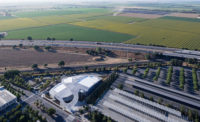At the same time that Snøhetta was designing an addition to the San Francisco Museum of Modern Art, the firm was in the thick of revamping another Northern California landmark— two projects of enormously different scales but equal intensity. Tucked away in the quiet Napa Valley town of Yountville, the small but world-renowned restaurant, The French Laundry, has been a gastronomic destination, and aspiration, for over two decades, and its owner, chef Thomas Keller, famous for his exacting standards. “The challenge with many of our projects is that our client is multiple people,” says Snøhetta founding partner Craig Dykers. “So with one person, it’s more specific, more precise, more focused.”
Chef Keller wasn’t looking to redesign the restaurant. In fact, nothing about the dining room was altered and not a single seat added. What he was after, instead, was a completely transformed kitchen. This wasn’t the first time he created a new cooking space since opening The French Laundry in 1994. He did so once before when he moved the original kitchen out of the restaurant itself, with a staff then that had grown from four to 50. It is now over a hundred.
Additional Content:
Jump to credits & specifications
But this latest renovation was major—spanning four years and costing $10 million. First, a temporary kitchen was built and the existing one torn down before construction of the new kitchen, and an annex for support functions and the 15,000-bottle wine collection, could even begin. Once that was completed, the temporary kitchen was dismantled and the landscape—a significant aspect of the project—was replanted.
“The philosophy of the menu hasn’t been impacted because of the change,” says Keller. “What has been impacted is efficiency and staff comfort.” The new 1,980-square-foot kitchen is only 25 percent larger than the previous U-shaped one. “Because kitchen work is about intimacy, you actually want things to be as close together as possible at the workstations,” explains Dykers, who, designing his first professional kitchen, spent hours on end with project director Nicolas Rader observing and sketching how the chefs worked. “It was difficult sometimes to make our analysis, because they would always be feeding us.”
Keller says he and Dykers instantly bonded when they first met, and the friendship eventually turned into a working relationship. “Our sensibilities are similar,” Keller says. “His designs are minimal, and I’m more of a minimalist rather than someone who likes to add many things. We have this idea that four ingredients on a plate is sufficient.”
From the exterior, the single-story, pitched forms of the kitchen and annex buildings are rather simple, referencing agrarian structures and conforming to the requirements of the historic neighborhood. The kitchen building is partly clad in charred wood, in the spirit of the traditional Japanese Shou Sugi Ban technique. A more contemporary fritted glass, with a dense composition of layered, swooping curves evocative of the motions of chefs’ hands at work, wraps the corner of the building. A ribbon window is perfectly positioned to provide views for the chefs out toward the half-acre grounds while allowing guests—who are encouraged to linger in the adjacent patio and other discrete areas of the garden for outdoor dining or casual drinks and cigars before and after meals—a glimpse of the inner workings of the kitchen.
The new landscape, also by Snøhetta, and designed to have a sense of random planting—some species of which are intended to grow onto the low-slung buildings—offers private nooks but also more open space. It also conceals the geothermal wells that provide all the refrigeration, heating, and cooling to the kitchen and annex. (A PV array over the entire roof of the annex satisfies up to half the electricity demand.)
The heart of the project, though, is inside the kitchen, where design tweaks, sometimes mere inches, greatly transformed work flow and circulation. Immaculately outfitted with state-of-the-art stainless-steel equipment that seems to float above the terrazzo floor, and walls and countertops in a white, antimicrobial surface, the light-filled space is topped by a dramatic curved ceiling. Formed from GFRG panels that are hung from the wood-frame structure, the ventilated ceiling, which required special approvals, replaces traditional hoods that are often in the line of sight. “There were a lot of inefficiencies before,” commented chef de cuisine David Breeden during a tour of the space. “It was visually unsavory.”
The ceiling’s arched shape improves the acoustics and communication among chefs—kitchens are notoriously loud, with all the banging and yelling—by bouncing sound back. Embedded within it, LED lights were carefully calibrated to the appropriate color temperature so that the food in the kitchen looks exactly as it does in the dining room. Some features, like a hearth, rotisserie, and cheese humidor, are new to this kitchen, while areas for butchering, prep, and dessert were expanded.
According to Dykers, Chef Keller asked for the best kitchen in the world. Almost a year into being operational, Keller says the new space is still evolving, and will continue to. “We realize there’s no such thing as perfection. It’s really the quest for perfection that drives you to move forward.”
CreditsDesign and Landscape Architect: Snøhetta—Craig Dykers, partner; Nicolas Rader, project director
Architect of Record: Envelope A+D—Douglas Burnham, principal
Consultants: Arup (acoustics); Martin Poirier, PWP Landscape Architecture (local landscape consultant); Harrison Koellner (food service); Kallos Turin (public interiors)
General contractor: Wright Contracting
Client: The French Laundry Partners |
SpecificationsCharred-Wood Panels Delta Millworks
Curtain Wall and Windows Kawneer
Fritted Glass Viracon
Solar Panels NRG
Ventilated Ceiling/Hoods Halton
Workstations Hestan
Ranges Bonnet, Hestan
Ovens Rational
Surfaces Cosentino
GFRG Panels GC Products
Pendant and Recessed Lights Zumtobel
Paint Benjamin Moore
|













